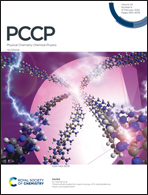Exploring structural dynamics and optical properties of UnaG fluorescent protein upon N57 mutations†
Abstract
UnaG is a new class of fluorescence protein in which an endogenous ligand, namely bilirubin (BLR), plays the role of chromophore. Upon photoexcitation, holoUnaG emits green light. A single mutation at residue 57 induces a decrease in the fluorescence quantum yield. To our knowledge, no atomic simulation at the atomic level has been carried out to date to explain this fluorescence decay in N57A and N57Q mutants. Herein molecular dynamics simulations were carried out on wild-type (WT) UnaG and both mutants to investigate the structural impact of the mutation on its global structure, on BLR and the absorption spectra. Our study reveals significant global changes upon mutation at the protein entrance (L3, H2, and, H3) governing a BLR modification. BLR in WT UnaG is rather rigid while when embedded into N57A or N57Q, dihedral angles between endo and exo vinyl moieties and between A and B rings at the entrance of UnaG are strongly modified along with the number of inter-/intramolecular interactions. The water molecules play an important role in the modification of the shape of the binding cavity. For the first time, we show that the structural modifications upon ligand mutations are tightly related to the key structural changes in the protein such as Loop3 (L3), β sheet 2 (B2), and β sheet 3 (B3) dynamics. The present work suggests that the quenching of the fluorescence properties of UnaG mutants is mainly a non-radiative process closely related to the BLR flexibility induced by global structural changes.



 Please wait while we load your content...
Please wait while we load your content...